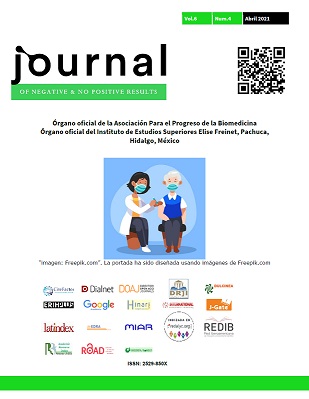Analysis of obesity in children from 6 to 12 years of Albacete during the COVID19 pandemic
DOI:
https://doi.org/10.19230/jonnpr.3966Keywords:
Childhood obesity, lifestyle, risk factorsAbstract
Introduction. According to the World Health Organization, childhood obesity is one of the most serious worldwide public health problems of the 21st century. In Spain, it is the most frequent nutritional disorder among children from 5 to 15 years old, with a prevalence of 34.1%.
Objetives. To analyze in a sample of 50 children with obesity, its main characteristics and its possible association with: family history of obesity, feeding with breastfeeding, accompanying pathologies, presence of weekly physical activity, hours of rest per day, time dedicated to video games, mobiles and the like and type of power.
Results. The variables associated with obesity were: being an only child (p= 0.011); Older mothers (p = 0.025); Absence of breastfeeding in the first months of life (p = 0.008); Sleep fewer hours (p = 0.045); Do not consume vegetables or greens (p = 0.019), or fruit (p = 0.033); Girls multiply by 2,611 the consumption of vegetables and the older the greater the consumption of fruit (p = 0.011); 74% ate between meals (snacks). Being a woman and having more than 6 years multiplied by 1,934 and by 12, respectively, the presence of pecking. The older the age, the more pecking (p < 0.001).
Conclusions. It is evident that family overweight, without breastfeeding in the first months of life, sleeping fewer hours than recommended for the child's age, and a diet poor in vegetables, fruit and vegetables, pecking between meals, play an important role in childhood obesity.
Downloads
References
Tárraga López PJ, Tárraga Marcos ML, Panisello Royo JM, et al. Resultados de una intervención motivacional con niños obesos o con sobrepeso y sus familias: estudio piloto. Rev Esp Nutr Humana Dietética 2017;21(4):313–9.
La prevalencia del exceso de peso debe disminuir en los países mediterráneos [Internet]. [cited 2020 Mar 26];Available from: https://evidenciasenpediatria.es/articulo/7473/la-prevalencia-del-exceso-de-peso-debe-disminuir-en-los-paises-mediterraneos-
Enrique GG. Prevalencia de sobrepeso y obesidad en España en el informe “The heavy burden of obesity” (OCDE 2019) y en otras fuentes de datos. y en 2019;9.
Aranceta-Bartrina J, Gianzo-Citores M, Pérez-Rodrigo C. Prevalencia de sobrepeso, obesidad y obesidad abdominal en población española entre 3 y 24 años. Estudio ENPE. Rev Esp Cardiol 2020;73(4):290–9.
Dalmau Serra J, Alonso Franch M, Gómez López L, Martínez Costa C, Sierra Salinas C. Obesidad Infantil. Recomendaciones del Comité de Nutrición de la Asociación Española de Pediatría. Parte II. Diagnóstico. Comorbilidades. Tratamiento. An Pediatría 2007;66(3):294–304. 6. Ibáñez A. MANIFESTACIONES ORTOPÉDICAS DE LA OBESIDAD EN NIÑOS Y ADOLESCENTES. 2017;1(1):9.
Rosa Guillamón A, Carrillo López PJ, García Cantó E, Perez Soto JJ, Tarraga Marcos L, Tarraga López PJ. Mediterranean diet, weight status and physical activity in schoolchildren of the Region of Murcia. Clin E Investig En Arterioscler Publicacion Of Soc Espanola Arterioscler 2019;31(1):1–7.
Early life risk factors and their cumulative effects as predictors of overweight in Spanish children | SpringerLink [Internet]. [cited 2020 May 18];Available from: https://link.springer.com/article/10.1007/s00038-018-1090-x
Heslehurst N, Vieira R, Akhter Z, et al. The association between maternal body mass index and child obesity: A systematic review and meta-analysis. PLoS Med 2019;16(6):e1002817.
Aguilar Cordero MJ. LACTANCIA MATERNA COMO PREVENCIÓN DEL SOBREPESO Y LA OBESIDAD EN EL. Nutr Hosp 2015;(2):606–20.
Zallo NÁ, Grima FG, Aguinaga-Ontoso I, Hermoso-de-Mendoza J, Fernández BM, Serrano-Monzó I. Estudio de prevalencia y asociación entre síntomas de asma y obesidad en la población pediátrica de Pamplona. Nutr Hosp :7.
Rosa Guillamon A, Garcia Canto E, Rodríguez García PL, Pérez Soto JJ, Tárraga Marcos ML, Tárraga López PJ. [Physical activity, physical fitness and quality of diet in schoolchildren from 8 to 12 years]. Nutr Hosp 2017;34(5):1292–8.
Moral García JE, Agraso López AD, Pérez Soto JJ, et al. [Phisical activity practice according to adherence to the Mediterranean diet, alcohol consumption and motivation in adolescents]. Nutr Hosp 2019;36(2):420–7.
Ruan H, Xun P, Cai W, He K, Tang Q. Habitual Sleep Duration and Risk of Childhood Obesity: Systematic Review and Dose-response Meta-analysis of Prospective Cohort Studies. Sci Rep 2015;5:16160.
Del Barrio Fernández Á. LOS ADOLESCENTES Y EL USO DE LOS TELÉFONOS MÓVILES Y DE VIDEOJUEGOS. Int J Dev Educ Psychol Rev INFAD Psicol 2016;3(1):563.
Estudio Nutricional sobre Población Infantil Española (EsNuPi). | Asociación Española de Pediatría [Internet]. [cited 2020 May 18];Available from: https://www.aeped.es/comite-nutricion-y-lactancia-materna/nutricion-infantil/documentos/estudio-nutricional-sobre-poblacion
Published
Issue
Section
License
All accepted originals remain the property of JONNPR. In the event of publication, the authors exclusively transfer their rights of reproduction, distribution, translation and public communication (by any sound, audiovisual or electronic medium or format) of their work. To do so, the authors shall sign a letter transferring these rights when sending the paper via the online manuscript management system.
The articles published in the journal are freely used under the terms of the Creative Commons BY NC SA license, therefore.
You are free to:
Share — copy and redistribute the material in any medium or format
Adapt — remix, transform, and build upon the material
The licensor cannot revoke these freedoms as long as you follow the license terms.
Under the following terms:
Attribution — You must give appropriate credit, provide a link to the license, and indicate if changes were made. You may do so in any reasonable manner, but not in any way that suggests the licensor endorses you or your use.
NonCommercial — You may not use the material for commercial purposes.
ShareAlike — If you remix, transform, or build upon the material, you must distribute your contributions under the same license as the original.
No additional restrictions — You may not apply legal terms or technological measures that legally restrict others from doing anything the license permits.

This work is licensed under a Creative Commons Attribution-NonCommercial-ShareAlike 4.0 International License

























